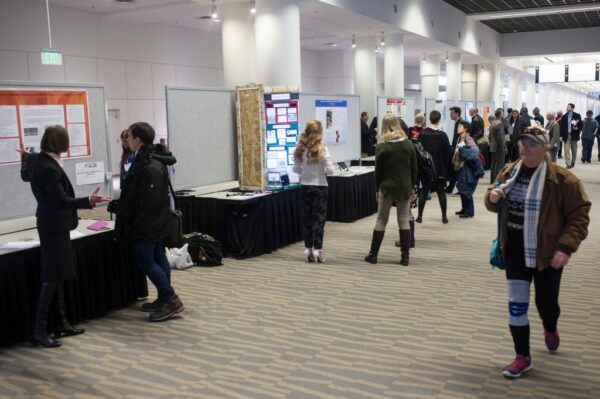If you have any doubts about the vibrancy of historical curiosity among our undergraduate majors nationwide, be sure to check out the Undergraduate Poster Session, which runs from 3:30–5:30 p.m. on Saturday, January 6, in the Atrium of the Marriott Wardman Park (Exhibition Level). Jewish pirates, Catherine de Medici, 1967 in Detroit, Egypt in 2017, indigenous communities in early colonial Connecticut—these are just a few samples of the historical subjects that have caught students’ attention and propelled them into the world of historical research, thinking, and writing. The energy and enthusiasm—and real historical insight—coming off of these projects are inspiring. And the range of topics and methods will remind you that we have much to learn from our own students.
Many if not all of the posters on display are the result of deep archival encounters you will find yourself envious of. Julia Palmerino of the College of the Holy Cross went to the National Archives in Dublin last summer to explore how Irish dance halls and especially the behavior of Irish girls and women came to be controlled by church and state. Lara Manbeck of New York University was able to travel to archives in Vietnam to research her project on commemorative naming in Saigon, or Ho Chi Minh City, in the context of decolonization and postwar anti-communism. Nia Blasingame of Howard University focuses on the writings of black activists who traveled to the Soviet Union to explore the impact of travel, especially in Central Asia, on the thinking and identity of artists like Paul Robeson and Langston Hughes. And Cory Starman (Univ. of Nebraska, Omaha) showcases the writing of Odo of Deuil, a French monk who accompanied King Louis VII on crusade in an interactive website that features his Latin 12th-century text, De profectione Ludovici VII in Orientem, in a form that allows it to be accessible to a variety of modern readers. The methodological breadth here is impressive. There are several projects with digital dimensions, reminding us of how tech savvy the next generation of historians already is. But it’s rarely technolology for its own sake: the authors here use it purposefully to reach broad audiences and are committed to getting us to think about how and why all history is, or can be, public history.
There is also a real sense of imagination and adventure about what counts as a historical source. Nala Chehade’s training at Virgina Tech has allowed her to see the graffiti produced in the Arab Spring uprisings as a powerful archive of revolutionary ambition. Highlighted by Alexyss McClellan (Univ. of California, Santa Cruz), the amazing photography of the Gail Project, which features a range of images connected to the US military in Okinawa, speaks as much to elderly Okinawans who remember the postwar era as it does to a range of scholars interested in Pacific histories. This heightened consciousness of audience runs throughout the posters, and not just because they themselves represent an alternative form of communicating historical research and knowledge. These students are clearly responding to the contemporary urgency we all feel, namely that historians must think boldly about the relationship of the past to the present and must work harder than ever to communicate their findings and their passions to a variety of “readers” through an equal variety of media. That a significant number of these posters are the result of collaborative interdisciplinary teamwork is also impressive—another reminder of what critically engaged historical research looks like.
Anyone who has ever done a poster project knows how hard it is to represent, and persuade, in visual form. It’s a very particular genre, and it’s not self-evident, even if your work already has a graphic dimension. And if you are accustomed to the long-form essays as your primary means of expression, the leap can be very hard to make. It’s a design challenge that requires deep knowledge of your subject, an aerial view of its contours, and considerable skill in the art of spatial argumentation.
The AHA committee that reviewed the undergraduate poster submissions had its work cut out for it, because there were truly so many excellent proposals to choose from. So mark your calendars for a Saturday afternoon stroll through this gallery of undergraduate research. It will restore your faith in the promise of our students and renew your conviction about the work you are doing in your own history classrooms in the new year. In fact, you really should encourage your students to consider proposing a poster for the next AHA annual meeting in Chicago in 2019. For details contact Joe Gardella, the AHA’s meetings and executive assistant.
This post first appeared on AHA Today.
Antoinette Burton is professor of history at the University of Illinois, Urbana-Champaign.
This work is licensed under a Creative Commons Attribution-NonCommercial-NoDerivatives 4.0 International License. Attribution must provide author name, article title, Perspectives on History, date of publication, and a link to this page. This license applies only to the article, not to text or images used here by permission.



